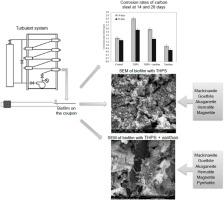Chemical Engineering and Processing: Process Intensification ( IF 3.8 ) Pub Date : 2020-12-15 , DOI: 10.1016/j.cep.2020.108272 Pulkra Silva , Sara H. Oliveira , Glória M. Vinhas , Ladimir J. Carvalho , Osmar S. Baraúna , Severino L. Urtiga Filho , Maria Alice G.A. Lima

|
In this study, satisfactory efficacy was found from the combination of the biocide THPS with the xanthan biopolymer for the control of microbiologically influenced corrosion in SAE 1010 carbon steel. The effectiveness of this combination was compared with three systems: without treatment and using THPS and xanthan in isolation. The experiments were carried out in a turbulent flow looping, in which the circulating medium was seawater. Quantification of microbial groups, corrosion rate measurements through mass loss, quantification of biomass and extracellular polymeric substances (EPS) of the biofilm were performed. The biofilm on the coupons was analyzed using the scanning electron microscope (SEM), and X-ray diffraction (XRD) was used to identify the crystallographic phases of the corrosion products. The results showed that, even with low concentration of xanthan added, the THPS + xanthan system had a greater reduction of microbial groups in relation to the other systems. This combination also reduced biomass and extracellular polymeric substances. Despite the presence of grooves, SEM indicated that xanthan forms a more adherent film on steel due to its dispersant property. And, finally, the lepidocrocyte phase was not found in the corrosion products from systems with THPS, whereas mackinawite phase was found.
中文翻译:

具有生物聚合物的Tetrakis羟甲基硫酸phospho(THPS)作为控制动态系统中微生物影响的腐蚀的策略
在这项研究中,通过将杀生物剂THPS与黄原生物聚合物结合使用,可以控制SAE 1010碳钢中受微生物影响的腐蚀,从而获得令人满意的功效。将该组合的有效性与三种系统进行了比较:未经处理且单独使用THPS和黄原胶。实验在湍流环流中进行,其中循环介质为海水。进行了微生物基团的定量,通过质量损失的腐蚀速率测量,生物膜的生物量和细胞外聚合物质(EPS)的定量。使用扫描电子显微镜(SEM)分析试样上的生物膜,并使用X射线衍射(XRD)识别腐蚀产物的结晶相。结果表明,即使添加了低浓度的黄原胶,THPS +黄原胶系统与其他系统相比,微生物群的减少量也更大。这种结合还减少了生物质和细胞外聚合物。尽管存在沟槽,SEM仍显示黄原胶由于其分散性能而在钢上形成了更牢固的附着膜。并且,最后,在具有THPS的系统的腐蚀产物中未发现鳞状上皮细胞相,而发现了马基诺石相。











































 京公网安备 11010802027423号
京公网安备 11010802027423号